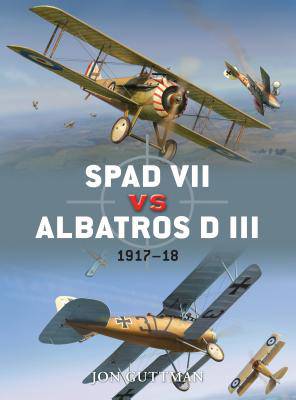
- Afhalen na 1 uur in een winkel met voorraad
- Gratis thuislevering in België vanaf € 30
- Ruim aanbod met 7 miljoen producten
- Afhalen na 1 uur in een winkel met voorraad
- Gratis thuislevering in België vanaf € 30
- Ruim aanbod met 7 miljoen producten
Zoeken
€ 23,95
+ 47 punten
Omschrijving
When originally conceived, the French SPAD VII and German Albatros D II represented steps away from an emphasis on maneuver in aerial combat in favor of speed and durability - factors that came into play in hit-and-run tactics. At the end of 1916, however, Albatros tried to have the best of both worlds by incorporating the sesquiplane wing of the nimble Nieuport 17 into its D III. The result combined the better downward view and maneuverability of the Nieuport with the power and twin machine guns of the Albatros D II, but at a high price - a disturbing tendency for the single-spar lower wing to fail in a dive.
While Albatros (and the Austrian Oeffag firm, which built the fighter under license) sought to alleviate that weakness with various reinforcing measures, the Germans developed tactics to maximize the D III's strengths and minimize its shortcomings. At the same time, the French worked to improve the SPAD VII with more power and a more reliable cooling system before moving on to the twin-gunned SPAD XIII. While all that was going on, the Albatros D III became a mainstay of the German and Austro-Hungarian air services in frequent encounters with SPAD VIIs flown by French, Belgian, British, Italian and American airmen.Specificaties
Betrokkenen
- Auteur(s):
- Illustrator(s):
- Uitgeverij:
Inhoud
- Aantal bladzijden:
- 80
- Taal:
- Engels
- Reeks:
- Reeksnummer:
- nr. 36
Eigenschappen
- Productcode (EAN):
- 9781849084758
- Verschijningsdatum:
- 19/04/2011
- Uitvoering:
- Paperback
- Formaat:
- Trade paperback (VS)
- Afmetingen:
- 183 mm x 244 mm
- Gewicht:
- 258 g

Alleen bij Standaard Boekhandel
+ 47 punten op je klantenkaart van Standaard Boekhandel
Beoordelingen
We publiceren alleen reviews die voldoen aan de voorwaarden voor reviews. Bekijk onze voorwaarden voor reviews.











